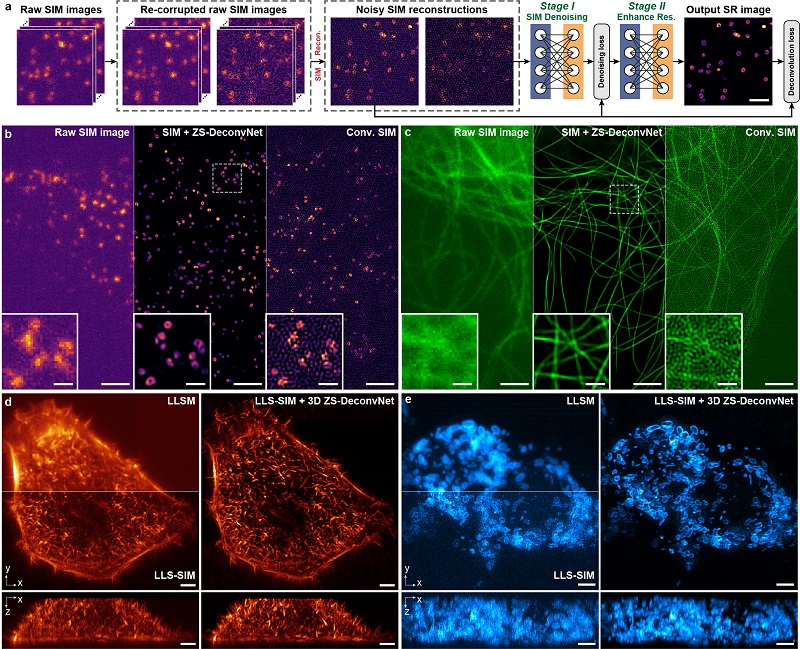Scientists Propose a Zero-shot Universal Microscopic Image AI Processing Method
Recently, the team of Prof. LI Dong from the Institute of Biophysics of the Chinese Academy of Sciences, in collaboration with the team of Prof. DAI Qionghai from the Department of Automation at Tsinghua University, published a research paper in Nature Communications. Based on the noise model of microscopic images and zero-sample learning theory, they proposed the zero-shot deconvolution networks (ZS-DeconvNet) and developed the corresponding one-click microscopic image processing software.
ZS-DeconvNet can use just a single low-resolution/noise ratio image for training in an unsupervised manner, stably increasing the resolution of microscopic images to over 1.5 times the diffraction limit, with a fluorescence intensity working 10 times lower than traditional super-resolution imaging conditions.
Researchers designed a physics-inspired self-supervised loss function based on the photon noise model, optical microscopic imaging model, and image spatial continuity. This function can learn denoising and super-resolution capabilities simultaneously without the need for additional training sets. And the researchers theoretically prove the convergence of the proposed loss function.
ZS-DeconvNet can handle various imaging modes including total internal reflection microscopy, three-dimensional wide-field microscopy, lattice light-sheet microscopy, and confocal microscopy. Notably, based on the theoretical discovery of the noise zero-expectation properties in structured illumination microscopy (SIM) image reconstruction, the researchers extended the proposed ZS-DeconvNet solution to SIM images, achieving the first unsupervised training of a noise-robust deep learning super-resolution model for SIM images.
ZS-DeconvNet can adapt to different biological imaging environments, even when biological processes are too dynamic and light-sensitive to obtain high-quality microscopic images. Compared to traditional iterative optimization-based deconvolution methods, ZS-DeconvNet has shown substantial improvements in qualitative and quantitative evaluations under all signal-to-noise ratio conditions, with data throughput increased by over 100 times.
The researchers collaborated to develop a one-click universal microscopic image processing Fiji plugin with integrated training and prediction functions, along with a corresponding tutorial homepage (https://tristazeng.github.io/ZS-DeconvNet-page/), enabling life science researchers, even those not specialized in AI, to use it easily.
Finally, the research team conducted extensive in vivo biological experiments, demonstrating the universality of ZS-DeconvNet. They found that ZS-DeconvNet can exhibit excellent performance in various imaging modalities in biological experiments, thereby contributing to life science research.

Fig.1 ZS-DeconvNet framework and exemplary processing effects
(Image by LI Dong's group)
Article link: https://www.nature.com/articles/s41467-024-48575-9
Contact: LI Dong
Institute of Biophysics, Chinese Academy of Sciences
Beijing 100101, China
E-mail: lidong@ibp.ac.cn
(Reported by Prof. LI Dong's group)

